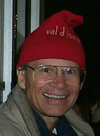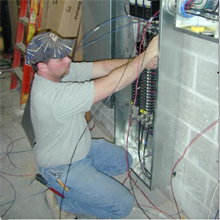 | Monday, January 9, 2006 |
|
Monday, January 9
Tuesday, January 10 |
|
|
Secon Level 3 |
|
Monday, January 9 - Minestroni - Pot Roast - Baked Chicken Enchiladas - BLT Ranch Wrap - Assorted Slice Pizza - Chicken Stir Fry The Wilson Hall Cafe accepts Visa, Master Card, Discover and American Express. |
|
Wednesday, January 11
Thursday, January 12
Chez Leon Menu |
| Fermilab Today is online at: http://www.fnal.gov/today/ Send comments and suggestions to today@fnal.gov Fermilab Today archive Hurricane Relief Page Fermilab Today PDF Version Fermilab Result of the Week archive Fermilab Safety Tip of the Week archive Linear Collider News archive Fermilab Today classifieds Subscribe/Unsubscribe to |
| Muons Inc. Will Co-Host Muon Collider Workshop | |||
Retired Fermilab physicist Rol Johnson and the company he founded in 2002, Muons Inc., are using Small Business Innovation Research (SBIR) grants for
basic research on future accelerators.
Despite problems associated with cooling beams of particles that only live 2.2 microseconds, the potential payoff of higher-than-ever energy collisions continues to motivate Johnson. Calculations indicate
Johnson and colleagues are still in the research stage, but he says, "We think we've got all the pieces and we now have to put them together to get a believable design for a muon collider and a neutrino factory." The Low Emittance Muon Collider Workshop may help to put it all together. More information can be found at the workshop website.
|
|
|
From World Science, January 5, 2006: Thriving under our noses, stealthily: coyotes Scientists have long thought coyotes intently avoid cities, but a new study has found the opposite. Groups of the historically maligned dog relatives are thriving in some large U.S. cities: they lurk in darkness and come out at night, probably helping the human inhabitants by eating vermin, the study found. This animalís amazing ability to thrive in cities has surprised scientists, said Stanley Gehrt of Ohio State University, who is studying coyotes in urban Chicago. Since the study began six years ago, Gehrt and his colleagues say they have found that urban coyote populations are much larger than expected; that they live longer than their rural cousins in these environments; and that they are more active at night than coyotes living in rural areas.
Coyotes also do some good: they help control rapidly growing populations of Canada geese throughout North America, Gehrt said. And while his coyote research is concentrated in Chicago, he said, the results likely apply to most major metropolitan areas in North America.
|
| Arc Flash: Hidden Danger | ||
An arc flash involves the flow of current through the air between conductors. Since the arc is extremely hot, a number of bad things happen very quickly. The arc radiates intense thermal energy resulting in potential skin/eye burns and fires. The sudden increase in temperature melts metals adjacent to the arc and produces a pulse of pressure. Loose objects, including molten metal droplets, as well as nearby people, can be propelled away from the arc. The pressure pulse also produces a loud noise that can damage hearing. FESHM chapters 5042 and 5040 have been revised to incorporate the arc flash precautions contained in a recent update to NFPA 70E, "Electrical Safety in the Workplace". The most important point to remember is that at Fermilab, we do not work on energized parts, either diagnostic or manipulative, unless special precautions, training and appropriate permits have been completed. In addition, you should stay away from electrical equipment that is being worked on and respect all barriers, signs and the directions given by the electrical worker or safety observer. |
|
January 4 - 6 - During the 48 hour period operations established one store that provided the experiments with 4 hours and 30 minutes of luminosity. - Kicker and Vacuum problems for 2 days. - New recycler stash record of 370.1 E30 set on Thursday evening. - New Tev Initial luminosity record of 171.85 E30 set on Friday owl shift. Read the Current Accelerator Update |
|
Summer Housing Requests
The Fermilab Housing Office is now taking requests for houses, apartments, and dormitory rooms for the summer of 2006. Since there will be a large influx of experimenters, and requests are anticipated to be in excess of our available facilities, you are urged to submit your request for reservations to the Housing Office by Wednesday, March 1, 2006. Requests can be made for any period and need not commence on any particular date. For further information, please call (630) 840-3777 or email housing@fnal.gov. Individual housing requests can be made by using our Online Housing Request form. (Requests for multiple housing units are best handled by direct email.) |


